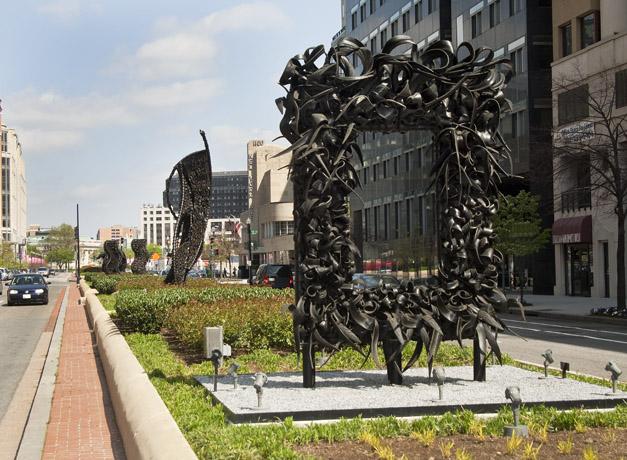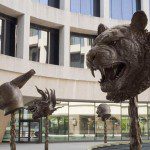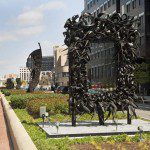Between the sculpture gardens at the National Gallery, the Kreeger Museum and Hirshhorn, there’s a lot to see around the streets of Washington. Throw in the fraternity of bronze-cast historic figures scattered throughout the city and there’s an all-star cast of artistic and historic characters around every corner. You’ll see Henri Moore and Henry Longfellow, Giacometti and Ghandi, Alexander Calder and Alexander Hamilton.
Indeed, there are so many longstanding outdoor fixtures that we miss on our daily commute alone (who among us has ever actually seen a Boundary Stone?), that it’s all too easy to overlook a new public installation. Doug Aitken’s “Song 1” at the Hirshhorn was a deserved success before it came down early last month, with projectors flashing a fully encompassing video around the building’s elliptical façade to a remixed exploration of the 1930s pop song “I Only Have Eyes for You.” It left audiences wanting more of that interactive, environmentally specific experience. Thankfully, the Hirshhorn isn’t lacking for new outdoor installations, and neither is the National Museum of Women in the Arts. And now is just the right time of year to be outside and experience them.
Chakaia Booker Scultures Roll Into New York Avenue
There is a peculiar group of sculptures on a well-kept, grassy median on New York Avenue between 12th and 13th Streets NW, amid the oil drum echoes of construction by Mount Vernon Square and the arterial bustle of downtown. Black and unusually textured, they appear almost aloof to their surroundings — curious as to what exactly is going on around them.
This is the work of sculptor Chakaia Booker, the second artist selected for the National Museum of Women in the Arts’ (NMWA) New York Avenue Sculpture Project, the only public art space featuring changing installations of contemporary works by women artists. Booker, by integrating discarded construction materials into large outdoor sculptures, works here with recycled tires which she slices, twists, weaves and rivets into radically new forms. Tires resonate with the artist for their versatility and rich historical and cultural legacy: The harvest and production of rubber is entwined with a history of brutal colonization, cultural injustices and slave labor in Africa and the world beyond.
Given the space they occupy, these sculptures are oddly modest in size, as if refusing to compete with surrounding noise and structures. They stick out from their environment by utter disassociation of urban aesthetics. They do not try to be big—and in this way they grow. These dancing forms, with interlacing planes that revolve through and around each other, are Brancusian in their suggestive shapes and movement, while their texture and tactility remain rooted somewhere firmly in the earth of this world.
They have the texture of nature, vines, bushes and nettles, like fictitious plants you might see in a Maurice Sendack illustration. Also like Sendack’s work, there is an undertow of darkness about them—a keyhole’s peek into a world of magnificent intrigue and epochal wrath. Perhaps it’s the wondrous patterns and textures against the sheer literality of the tires—once you get close to them, the sculptures are upfront about their material: masses of diced, slit rubber and hundreds of heavy screws securing them to their skeleton.
While there is a good chance you already passed them by without even noticing their presence, Chakaia’s sculptures are worth serious consideration. The good news is they will be on view through 2014, so there’s time to see them.
For more information visit www.NMWA.org.
Ai Weiwei Turns Heads at the Hirshhorn
“Circle of Animals/Zodiac Heads” is the first major US public art project by internationally renowned Chinese artist and political activist Ai Weiwei. The installation comprises a dozen bronze sculptures, each roughly ten feet tall, that represent the signs of the Chinese zodiac (snake, horse, ram, monkey, rooster, dog, pig, rat, ox tiger, rabbit and dragon).
The sculptures are re-envisioned and enlarged versions of original eighteenth-century heads that were designed during the Qing dynasty for the fountain clock of the Yuanming Yuan (Garden of Perfect Brightness), an imperial, European-style retreat outside Beijing, which was pillaged in 1860. The Hirshhorn placed them encircling the fountain in the center of the Hirshhorn’s rounded courtyard.
Weiwei went to great pains to depict the animals with detail, down to the veins in the rabbit’s forehead and the chicken’s grainy crown, every surface suggestive of hair, feathers or skin. The heads cut off abruptly at the neck, the stanchions they are affixed to connecting rather artlessly underneath, as if they were each severed from the body and mounted on coarsely carved wooden spikes—like the pig’s head in William Golding’s “Lord of the Flies.”
There is always a lot of historical and political baggage when dealing with Ai Weiwei—and I mean that in the best possible way. A noted dissident, Weiwei has spent his career speaking up against social and political oppression in his homeland. He is a master of the conversation between abrasive confrontation (including a photographic series of his own middle finger interrupting otherwise innocuous snapshots of historic Chinese landmarks, such as Tiananmen Square) and subtle symbolism (covering the floor at London’s Tate Modern with hand-painted porcelain sunflower seeds—a comment on mass consumption, among countless other things).
Knowing this, why would Weiwei go to the effort of such odd and meticulous realism if he didn’t mean them to be perceived that way? Without forcing anything on the audience, the work raises questions about repatriation and intention as well as our own blindness to suffering, religious misinterpretation and historical injustice.
For more information visit www.Hirshhorn.si.edu.
- Booker Installation




